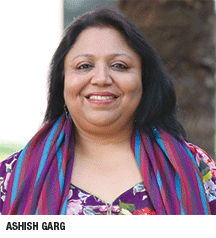 AS THE NEW ACADEMIC YEAR approaches, schools are planning and budgeting for big ticket purchases in preparation for the next year. This is a good time for school managements to pay heed to emerging trends in 21st century education to avoid investing mega bucks in technology which is cumbersome, expensive and on the threshold of obsolescence.
AS THE NEW ACADEMIC YEAR approaches, schools are planning and budgeting for big ticket purchases in preparation for the next year. This is a good time for school managements to pay heed to emerging trends in 21st century education to avoid investing mega bucks in technology which is cumbersome, expensive and on the threshold of obsolescence.
The pace of change in education is rapid and of technology even more so. Parental expectations of schools are also changing. The latter must start producing faster, smarter and better school-leavers. This is possible through intelligent infusion of technology into education.
While there is general acceptance that ICT is a game changer in education, ubiquitous use of the internet will be a total ‘disrupter’. The US-based business magazine Forbes has just released its ‘Forbes 30 under 30’ list of the brightest young stars — creators of multi-million dollar enterprises, and all of them are in web-based businesses.
Contemporary school and college leavers are confronted with the challenges of a dynamic, entrepreneurial and impatient digital world. There is no escaping the imperative that all schools must urgently provide broadband internet access. With the influx of high speed, low cost, cheap devices, technology is rapidly becoming synonymous with the worldwide web and the distinction between hardware and software is fast blurring. Therefore a top priority of school promoters, trustees and principals should be investment in high speed broadband access for their schools.
However despite the urgent need for internet access for almost everything — from the latest teaching tools to education content to discussion platforms and educator collaboration groups — most schools including some among India’s Top 100 don’t have broadband access. Most of them choose from a range of internet service providers and make do with poor quality and expensive service.
Some schools are fearful of misuse and abuse of the internet. However, as principal Samik Ghosh of Scindia Boys, Gwalior, says, issues of access and security are much the same as parents have at home. “But learning cannot be compromised. The most effective solution is to counsel students and create an environment which encourages them to learn,” he says. Moreover technology administrators can easily fix these challenges. There are YouTube video lessons which can help even a novice learn how to install controls on internet usage.
Another interesting buy is the Google Chrome books now available in India through IT majors such as Samsung, HP, Dell and Acer. Chrome books function like a typical PC but use the cloud for all applications, which means there is no need to purchase the usual software and software licences because it simply links up to the cloud. A cloud means a set of huge servers connected to individual computers via middleware. Google, Apple, IBM and Microsoft are some of the big companies investing in cloud computing. All applications such as Google Apps for Education which offer email, calendar, documents, data, and more are stored in a ‘cloud’ and can be accessed anywhere, agnostic of device. In addition, they connect to common wifi wireless networks which saves costs of anti-virus protection and updates. Priced in the range of Rs.25,000-27,000 per unit, they can be linked with a Smartboard to serve the needs of an entire classroom.
Another vitally important issue which school/college managements need to address is using online resources for professional development. Moocs (massive open online courses) provide unprecedented opportunities for anytime, anywhere learning. Coursera, the world’s largest provider of Moocs, has nearly 6 million registered users and offers 553 courses ranging from Roman architecture at Yale to chemistry at Rice University. Udacity, Udemy and edX are other Mooc providers with globally accessible study programmes. Coursera recently established learning hubs which enable groups of students to simultaneously access Mooc lectures. India’s Bluebells International School, New Delhi hosts one such learning hub. In particular, Moocs can prove very useful for teacher training and development programmes, especially in remote residential schools.
Schools can also create learner communities using Moocs. These communities can be in-school or span a wider network of schools in a city or district, creating new collaborative learning models which increase the depth of learning and sharing at many levels. Above all, enterprising schools can also create their own Moocs. Check out the modus operandi on Mooc.org (a partnership between edX and Google to create a Mooc authorship platform), and the current offering from OpenLearning.
For responsible school managements (promoters, trustees, principals, teachers), 2014 could be an exciting year offering numerous options for sharply improving students’ learning outcomes through intelligent use of latest technologies, while simultaneously offering new pathways for sharing, collaborating and learning with ease and efficiency.
(Ashish Garg is a former member of the United Nations ICT Task Force and education futurist)